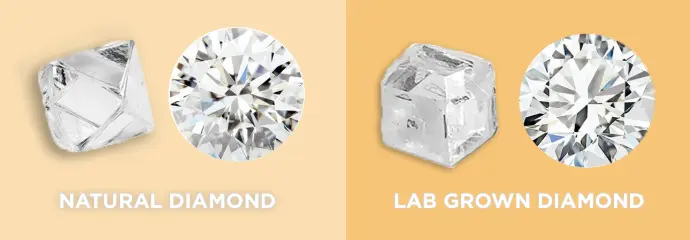Diamond Types
Discover the Sparkle: A Guide to Diamond Types

| Feature | Natural Diamond | Lab-Grown Diamond |
|---|---|---|
| Origin | Formed deep within the Earth's mantle over billions of years under intense heat and pressure, then brought to the surface by volcanic eruptions. | Created in a controlled laboratory environment over a few weeks or months using advanced technology (HPHT or CVD methods) that replicates the natural formation process. |
| Chemical/Physical Properties | Identical: Pure carbon arranged in a crystalline lattice. Same hardness (10 on the Mohs scale), brilliance, and durability. | Identical: Pure carbon arranged in a crystalline lattice. Same hardness (10 on the Mohs scale), brilliance, and durability. |
| Optical Properties | Identical: Same fire, scintillation, and sparkle. | Identical: Same fire, scintillation, and sparkle. |
| Rarity | Considered rare due to the natural, finite, and billion-year process of formation and difficult mining. | Not inherently rare, as they can be produced on demand and in large quantities. |
| Inclusions/Trace Elements | Typically contain natural inclusions and trace elements (most commonly nitrogen). The nature and shape of inclusions are often diagnostic. | May have different, subtle identifying characteristics related to the growth process, such as unique growth patterns or metallic inclusions (from the HPHT process). Generally free of nitrogen. |
| Price | Significantly more expensive (typically 30-75% more) due to the rarity, mining costs, and controlled market. | Significantly less expensive than a natural diamond of comparable quality (Carat, Cut, Color, Clarity). |
| Value Retention | Historically retains value better, though resale value is typically much lower than the original purchase price. Often seen as a traditional investment piece. | Value is consistently decreasing due to advancements in technology and increased production efficiency. Resale value is generally lower than natural diamonds. |
| Identification | Requires specialized gemological equipment to definitively distinguish from lab-grown diamonds, often by detecting trace elements or specific growth patterns. Typically laser-inscribed with a certificate number. | Requires specialized gemological equipment to definitively distinguish from natural diamonds. Usually laser-inscribed with a label (e.g., "LAB GROWN") on the girdle. |
| Environmental/Ethical Concerns | Mining can involve significant environmental impact (land disruption, energy use) and potential ethical concerns ("conflict diamonds"), though many producers adhere to responsible mining practices. | Generally considered to have a smaller environmental footprint than mining, but the production still requires considerable energy (which can come from sustainable sources). Ethical concerns regarding conflict are absent. |
| Feature | Natural Diamond | Lab-Grown Diamond |
|---|---|---|
| Origin | Formed deep within the Earth's mantle over billions of years under intense heat and pressure, then brought to the surface by volcanic eruptions. | Created in a controlled laboratory environment over a few weeks or months using advanced technology (HPHT or CVD methods) that replicates the natural formation process. |
| Chemical/Physical Properties | Identical: Pure carbon arranged in a crystalline lattice. Same hardness (10 on the Mohs scale), brilliance, and durability. | Identical: Pure carbon arranged in a crystalline lattice. Same hardness (10 on the Mohs scale), brilliance, and durability. |
| Optical Properties | Identical: Same fire, scintillation, and sparkle. | Identical: Same fire, scintillation, and sparkle. |
| Rarity | Considered rare due to the natural, finite, and billion-year process of formation and difficult mining. | Not inherently rare, as they can be produced on demand and in large quantities. |
| Inclusions/Trace Elements | Typically contain natural inclusions and trace elements (most commonly nitrogen). The nature and shape of inclusions are often diagnostic. | May have different, subtle identifying characteristics related to the growth process, such as unique growth patterns or metallic inclusions (from the HPHT process). Generally free of nitrogen. |
| Price | Significantly more expensive (typically 30-75% more) due to the rarity, mining costs, and controlled market. | Significantly less expensive than a natural diamond of comparable quality (Carat, Cut, Color, Clarity). |
| Value Retention | Historically retains value better, though resale value is typically much lower than the original purchase price. Often seen as a traditional investment piece. | Value is consistently decreasing due to advancements in technology and increased production efficiency. Resale value is generally lower than natural diamonds. |
| Identification | Requires specialized gemological equipment to definitively distinguish from lab-grown diamonds, often by detecting trace elements or specific growth patterns. Typically laser-inscribed with a certificate number. | Requires specialized gemological equipment to definitively distinguish from natural diamonds. Usually laser-inscribed with a label (e.g., "LAB GROWN") on the girdle. |
| Environmental/Ethical Concerns | Mining can involve significant environmental impact (land disruption, energy use) and potential ethical concerns ("conflict diamonds"), though many producers adhere to responsible mining practices. | Generally considered to have a smaller environmental footprint than mining, but the production still requires considerable energy (which can come from sustainable sources). Ethical concerns regarding conflict are absent. |